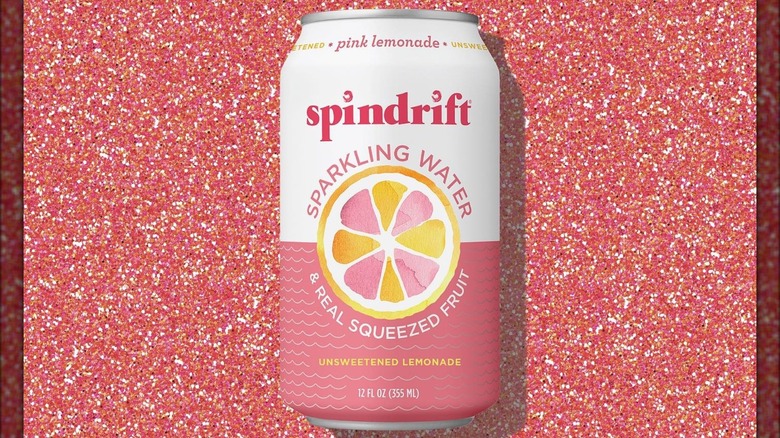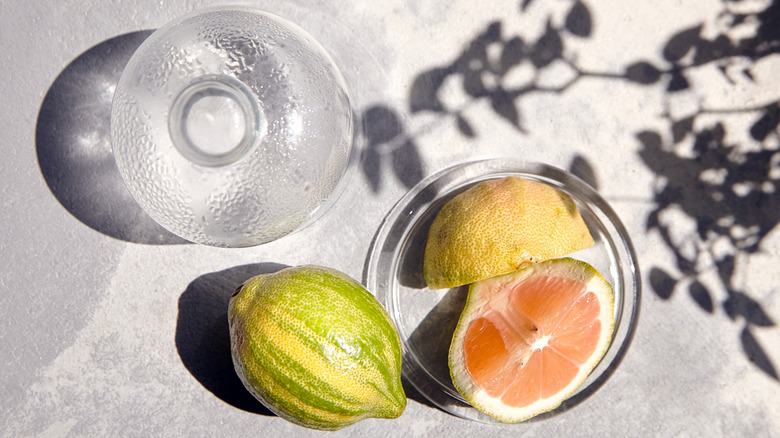Is Pink Lemonade A Unique Flavor, Or Just Pink?
Lemonade has been around for a long, long time — the ur-lemonade was a sweetened citrus drink dating to the 10th century, while in 17th-century Paris the stuff was sold by street vendors. Pink lemonade, however, is a more modern invention created by accident by a 19th-century circus worker who dropped cinnamon candies into a fresh batch of lemonade. The original pink lemonade, which was a hot seller in circus circles, would have had a unique flavor from the candies' faint hint of cinnamon and extra sugar. Modern pink lemonade, however, may or may not be different from the standard kind.
In some cases, pink lemonade gets its rosy hue from the addition of red juice from fruits like strawberries or raspberries. Fans of "Queer Eye" may even remember the baffling pink tomato juice lemonade served on an episode of the show. In these instances, the lemonade most likely does have a faint flavor from the secondary fruit. If a significant amount of extra fruit juice is added, however, this may tip the balance to the point where it's no longer simply pink lemonade, but instead raspberry/strawberry/tomato lemonade. Another typical way to make pink lemonade is by adding a few drops of food coloring to the basic lemon, sugar, and water mix, in which case the flavor is identical to standard lemonade unless you have a really sensitive palate. Still, there may be a certain psychological factor at work, since there are those who swear that pink lemonade always tastes different while others think lemonade is lemonade no matter the color.
Pink lemonade products may just be lemon-flavored
Where things really start to get iffy is when it comes to pink lemonade-flavored products. Many of these are dessert items such as pink lemonade donuts, pink lemonade cake mix, pink lemonade popsicles, and pink lemonade candies. Even KitKats now come in a pink lemonade variety which, surprisingly, is not a Japanese-exclusive KitKat flavor. The problem with all of these items, when considered from an overly analytical standpoint (as is our wont), is that when it comes to sweets, what makes the lemon and sugar "pink lemonade" flavor combo any different from that of plain old lemon donuts, cake, ice pops, and candies?
One non-dessert product that comes in both lemon and pink lemonade flavors does go out of its way to differentiate the two: Spindrift. The brand, which makes sparkling water with a tiny smidge of fruit juice, says that its pink lemonade is a bit sweeter than the lemon and contains some extra flavorings. The respective ingredient labels bear this out, as the pink lemonade variety is made with cherry juice, lime juice, and hibiscus in addition to lemon and water, while lemon Spindrift contains only these last two ingredients. Spindrift's products do not contain sugar or sugar substitutes, though, so neither beverage is really what you might call lemonade-like.
Pink lemons also don't taste much different from yellow ones
If you're shopping in the kind of gourmet grocery store that carries a wide range of specialty produce items, you may run across a fruit labeled "pink lemonade lemons." While the fruits have green and yellow stripes on the outside, if you cut them open, you'll find blush-colored flesh. Their more formal name is "variegated pink-fleshed Eureka lemons," and, like pink lemonade itself, they seem to have evolved by accident. Someone growing Eureka lemon trees in their garden found that one had "thrown a sport," which is a botanical term for a genetic mutation causing a plant to behave differently than it ordinarily would. As the pink coloring seemed like it would be cool to have in a lemon, the sport was cultivated to breed a new strain.
Variegated Eurekas are often advertised as being perfect for pink lemonade since their juice is pink (albeit a rather pale shade). Do they taste any different, though? Some find them to be slightly floral and a touch sweeter than the Eureka or Lisbon lemons commonly sold in grocery stores. Others, however, say they taste just like any other lemon, which brings us back full circle to the whole pink vs. standard lemonade debate. Is there any real difference between the two? It's all in the eye — or mouth — of the beholder.


